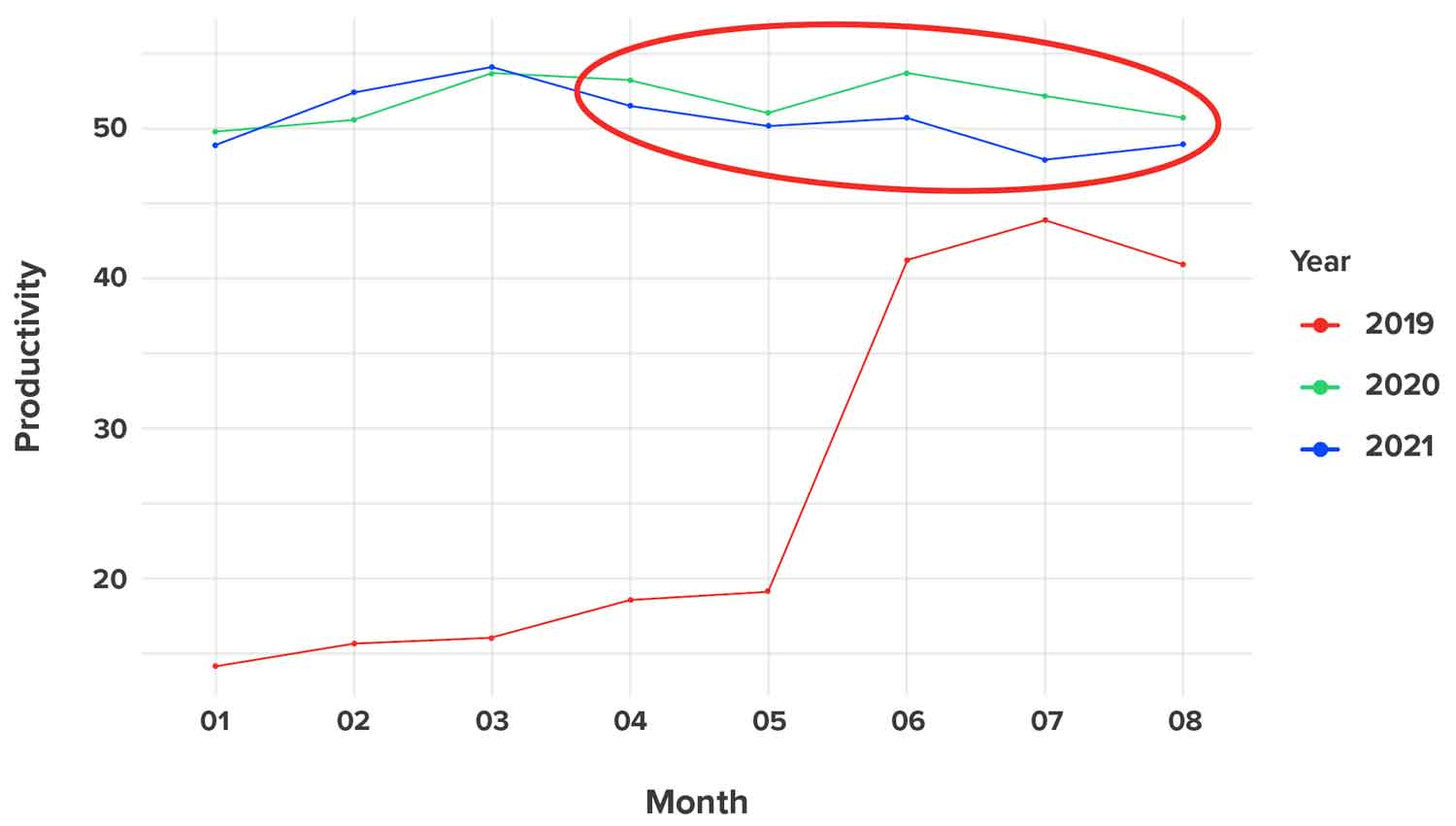Why Were Some Employees Less Productive in 2021?
New data in a report from Prodoscore, Productivity is Down in 2021.
Compared to 2020, shows that employee productivity dipped in 2021 below 2020 levels. Why did this happen when we were collectively emerging from a pandemic in 2021, rather than being mired in one during most of 2020? The data reveals multiple answers to this question.
Data was gathered by a third-party Data Science team in partnership with the Prodoscore Research Council. Data analyzed was from January 2020 to August 2021. It covered over 4,800 employees, 156 organizations, and over 32 million data points.
Keep in mind that productivity massively increased in 2020 over 2019
Year over Year Productivity
When comparing productivity year over year, there was a decrease in 2021

While the productivity dip between 2020 and 2021 may leave some scratching their heads, part of it may be due to “getting back to normal.” Throughout 2020, many areas of the country were in lockdown or at the very least advised to limit travel and any outside activities. That left very little to do with one’s time but work. When 2021 brought about the lifting of these lockdowns, employees may have started reconnecting with friends and family instead of working - which some would argue would lead to a healthier work/life balance anyway.
Additionally, there’s the fact that 2021 and 2020 were both still massively more productive than 2019. With no pandemic in play, 2019 was less productive than either 2020 or 2021, and the decrease between 2020 and 2021 was minimal.
Summer dips and COVID surges responsible for some of the “dips”
2020 and 2021 both saw productivity dips during COVID surges and the summer months, when productivity naturally wanes due to vacations. July 2021, for example, saw a drastic drop in productivity - probably due to the fact that it was the first summer month with lockdowns lifted. August 2021 almost made up for it in improved productivity as everyone got back to work. Message and chat was up for higher productivity workers during summer months, potentially as a result of them checking in with work while on vacation or simply trying to remain engaged
Average work days were longer in 2021
Paradoxically, work days were longer in January - August 2021 than they were in January - August 2020 - a factor which should have led to increased productivity. Until May of 2021, productivity was almost identical to 2021 numbers. It is only when entering the summer months that productivity began to significantly decrease, so this could really just be people enjoying their summer more than anything else. The longer work hours were only longer because people were working much fewer hours than they were pre-pandemic in 2020; so, the longer work days are another signal of getting back “to normal.”
Mid-late April saw high and average productivity workers losing steam
Another key factor in the 2021 productivity loss may have been burnout, as evidenced by a dropoff in productivity from typically high and average productivity workers in April of 2021, while low productivity workers stayed roughly the same with their levels of output. While it is a hypothesis, workers who had consistently been performing at high and average levels without a meaningful break may have begun feeling the strain in early Spring of 2021. For many people, early Spring 2021 really did feel like an “all work, no play” period of time, with months to go until summer began and lockdowns were lifted.
CRM and Calendar use also dropped in summer months
Interestingly, high-productivity workers nearly always show a high level of Customer Relationship Management (CRM) software use - much more so than the average and low productivity groups. As a complete aside, this is another reason companies may want to look at increasing user adoption of their CRM solutions - they tend to cultivate higher productivity according to this data. But even CRMs couldn’t draw high productivity workers when the summer hit, their use dropped drastically. Both high and average productivity workers similarly dipped out of Calendar solutions during the summer, somewhat predictably.
Low productivity workers mostly remained the same throughout
The “low bar” on all of the data for low productivity workers was almost a flat line throughout 2021 and 2020, with a small exception in a significant dip at the end of 2020 and the beginning of 2021 which affected all workers of any productivity level. This would seem to suggest that low productivity workers tend to show little productivity regardless of circumstance - whatever is happening in the world, and wherever they’re working from. .
Mental health programs may help to move the needle on productivity since overall mental wellness involves not living in the dissociative state which most of these low productivity workers seem to exist in. One on one coaching can also help!
Burnout and well-deserved vacations mostly responsible for 2021 dip
Companies need not be concerned that the sky is falling if productivity dipped in 2021 - it means that those who had been working stoically throughout the pandemic got a proper rest, in most cases.
As we have pointed out, 2020 and 2021 still far outpaced 2019 in terms of productivity, which is a marvel considering all of the stress we have collectively dealt with during the pandemic. It almost seems like the world was turning to work as a coping mechanism. Some industries that saw a massive uptick due to the pandemic didn’t really have a choice - if you were in healthcare or tech, for example, your work life became very busy, very fast compared to what your career was like in 2019.
The relationship between productivity and stress was highlighted by the pandemic. People who worked at average to high productivity levels dipped significantly when they maintained higher levels of productivity over a significant period of time, or when COVID surges hit. There’s a lesson for employers there - beware of burnout, don’t let your employees go too long between vacations, and give them some well-deserved down time after a big project or a sustained busy season.
The summer of 2021 saw productivity jump off a cliff, but only because it was the first time people could enjoy a true vacation with nice weather after the lockdown had been lifted. Many people took vacation time that they’d been saving so they could actually do something with it after lockdowns and restrictions were lifted.
A productivity management solution like Prodoscore can help businesses manage their human resource efforts. Low productivity employees can be identified, which means that they can be helped. High productivity employees, in turn, can be rewarded and monitored for potential burnout. It goes without saying that if star performers on any team flame out, they leave giant shoes to fill - so keep them from burning the candle at both ends by using data to identify when they may be at risk.
Contact us today for a demonstration of how Prodoscore can transform your human capital management permanently, and for the better.
Access the full report on our Prodoscore Research Council page.

